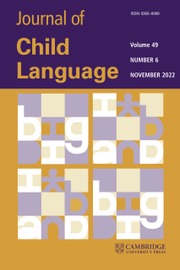Article contents
A discourse analysis of deixis: pragmatic, cognitive and semantic factors in the comprehension of ‘this’, ‘that’, ‘here’ and ‘there’*
Published online by Cambridge University Press: 26 September 2008
Abstract
Children (mean age 3; 6) were tested as to the comprehension of the deictic words this, that, here and there in two conditions: as hearers–addressees and as hearers–spectators. It was hypothesized that comprehension of these words depends on the role the comprehender plays in the conversation, and that a spectator's role is more difficult than an addressee's. Comprehension in a pragmatic condition (with a pointing gesture accompanying the utterance) was contrasted with a semantic condition (without gesture), and the prediction was that the pragmatic use of the words would facilitate comprehension. It was also theorized that this and here are marked, whereas that and there are unmarked. Therefore, it was predicted that this and here would be more difficult to comprehend than that and there. All the initial predictions were confirmed by the analysis of variance. The results are discussed within recent theories of pragmatics, semantics and cognitive development.
Information
- Type
- Articles
- Information
- Copyright
- Copyright © Cambridge University Press 1983
Footnotes
The first author is currently teaching at UNAERP, in Ribeirão Preto, São Paulo, Brazil, and is a Ph.D. student at the Instituto de Estudos da Linguagem, at the Universidade de Campinas, São Paulo, Brazil. Address for correspondence: Roberta L. Klatzky, Department of Psychology, University of California, Santa Barbara, CA 93106.
References
REFERENCES
- 17
- Cited by

